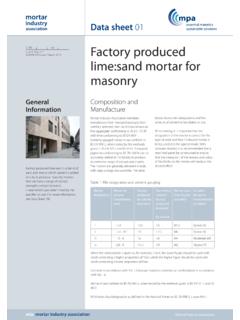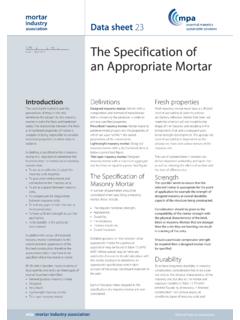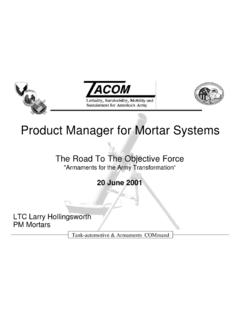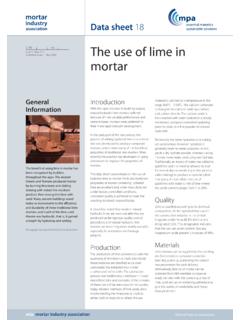Transcription of Mortar testing
1 CI/SfBYq4 Issue 1 May 2017 Data sheet 11 Mortar testingIn the UK factory produced Mortar must comply with the requirements of the European Standard BS EN 998-2 Specification for Mortar for masonry, Part 2: Masonry Mortar . The standard, details the properties to be measured and the procedures that are required before a product can commence manufacture and be offered for sale. The tests specified in the standard are used during the Initial Type testing (ITT ) phase after product development; this establishes the individual property values to enable a formal declaration of performance (DoP) to be made and the issue of CE marks. Values obtained during ITT are used for factory production control and for comparison against other future test testing is undertaken on material in its fresh(1) state or on hardened Mortar .
2 General informationTesting Mortar is undertaken for a variety of reasons these include, the evaluation of conformity to a specification or standard, to control and monitor the consistency of a product or process, to examine performance against project specific requirements and as part of an investigation in to a specific issue or to understand a , whether on site or in a laboratory, should always be carried out by suitably trained, experienced and supervised staff with appropriate, well maintained testing equipment and resources. Care should always be taken in the storage and transport circumstances of all samples to avoid unintentionally affecting the test four principle forms of testing which can be undertaken:i) Production Control testing : The manufacturer of finished construction materials and components will routinely undertake testing to monitor and control production processes.
3 For example, a producer of aggregates for Mortar will measure particle size distribution on a regular basis and use variations in results to adjust the production process. ii) Performance testing : assesses the end performance of a construction material against established criteria. For example, strength testing hardened Mortar is becoming increasingly important as new product standards enable Mortar to be designed to a minimum strength rather than being supplied to a recipe (prescription).iii) Compliance testing : This involves testing materials or components against the requirements of a contract specific specification or a published ) Analytical testing : This involves investigating problems in order to resolve causes of issues for example, chemical analysis of hardened Mortar to determine the cement content of a prescribed Mortar .
4 (1) Mortar described as fresh includes material that has been retarded for a required period of time and remains in a usable / plastic state. mia Mortar industry associationMineral Products AssociationCompressive strength test equipmentDropping ball apparatusSome of the equipment used to measure the consistence of fresh two standards that are applicable for testing Mortar are, BS EN 1015 - Methods of test for Mortar for masonry (a multi-part standard) and BS 4551 - Methods of test for Mortar Chemical analysis and physical testing . Table 1, below, lists all the applicable test method standards:-sand becomes coarse the percentage of the larger size fractions increases, the finished Mortar may become excessively wet with the same water addition, again affecting the Mortar characteristics fresh mortarTesting Mortar in its fresh state is covered in both BS 4551 and BS EN 1015.
5 Fresh Mortar properties are those that affect the ability to use Mortar for its intended application. Fresh Mortar test methods are used; to design new Mortar mixes, to assess alternative constituents and as a performance indication when undertaking factory production control testing . They can also be used to assess compliance with a standard and as an investigation tool. Most factory produced mortars contain precisely dosed admixtures that provide, when mixed as intended by the manufacturer, an optimum Mortar for the end user. Incorrect mixing either to excess or less than required during test specimen preparation may alter the fresh Mortar fresh Mortar must be performed within a defined period of time and before the Mortar has begun to set. testing Mortar constituentsTesting the performance of the cement component of Mortar is made by measuring the strength of the finished Mortar under specified laboratory various constituents used to produce Mortar are routinely tested to established standards by the constituent manufacturer in order to demonstrate grade or type.
6 However, Mortar manufacturers will also test the main constituents on a routine basis. This is because minor variations in their properties can have a significant impact on the finished Mortar . The main components of Mortar are fine aggregate (usually referred to as sand) and cement. The test to assess sand is the determination of particle size distribution also known as the sieve test or grading this test assesses the amount of individual size fractions the sand contains, as a percentage of each size that passed a certain test sieve. If sand becomes fine , the percentage of the smaller size fractions increase, the finished Mortar may appear stiffer than normal and require more water to give the same workability, which would adversely affect the water:cement ratio of the Mortar and hence its strength and other characteristics.
7 If the Workable life of Mortar is a measurement of the time taken for a sample of Mortar , prepared to a defined level of workability, to stiffen to a point where it is no longer usable for its intended application. The test for water soluble chloride content of fresh Mortar ensures that masonry containing embedded metal, such as wall ties, remains durable and is not prone to corrosion. Maximum total chloride contents by mass of cement are specified in the relevant code of practice. Chloride content is the only chemical test method within the BS EN 1015 series of Standards. The consistence of fresh Mortar is measured using the Flow Table, the Plunger Penetration or the Dropping Ball test methods, these methods are performed in a laboratory with results compared against established values or routine production control results.
8 Variation from established values may indicate a change in the physical properties of one of the constituents. Bulk density and air content measurements are made to assess fresh Mortar performance against previously determined values. Bulk density measurements are generally only performed in a laboratory since it requires the use of accurate weighing equipment. Air content can be determined at the point of use on the construction site. testing hardened mortarThe properties of hardened Mortar that are measured or declared under BS EN 998-2 include Compressive strength, Bond strength, Water absorption, Water vapour permeability, Density, Thermal conductivity (applicable for mortars intended to be used in elements subject to thermal requirements) and prescribed mortars the original mix proportions can be estimated when a hardened Mortar sample is chemically analysed using the methods provided in BS majority of hardened Mortar testing is undertaken by a Mortar Manufacturer during the development of a new product.
9 Following this development stage the BS EN 1015 - 1 Determination of particle size distribution (by sieve analysis)BS EN 1015 - 2 Bulk sampling of mortars and preparation of test mortarsBS EN 1015 - 3 Determination of consistence of fresh Mortar (by flow table)BS EN 1015 - 4 Determination of consistence of fresh Mortar (by plunger penetration)BS EN 1015 - 6 Determination of bulk density of fresh mortarBS EN 1015 - 7 Determination of air content of fresh Mortar (i)BS EN 1015 - 9 Determination of workable life and correction time of fresh mortarBS EN 1015 - 10 Determination of dry bulk density of hardened Mortar PBS EN 1015 - 11 Determination of flexural and compressive strength of hardened mortarBS EN 1015 - 17 Determination of water-soluble chloride content of fresh mortarBS EN 1015 - 18 Determination of water absorption due to capillary action of hardened mortarBS EN 1015 - 19 Determination of water vapour permeability of hardened rendering and plastering mortarBS EN 451 Mortar - methods of test for Mortar - Chemical analysis and physical testingTable 1: Mortar test method standardsThe test methods for all parts stated above can be found within the Standard itself.
10 Outline guidance on the test methods is also avail-able in MIA learning text 08 via the MIA website at performance of the product is confirmed through Initial Type testing , all of this testing is undertaken before a new product is offered for sale. Once available, some of the tests used as part of the development and ITT of the product, are then routinely performed for production control. Compressive strength is a test routinely used to measure the end performance of hardened Mortar . It is applicable for production control, performance and compliance testing . With regards to analytical investigation and the assessment of in situ Mortar , compressive strength cannot be determined due to insufficient specimen size of the placed Mortar . However, test data recorded at or around the time the Mortar under consideration, was produced, as part of the manufacturers routine testing , can be taken into account as part of an determination of compressive strength relies upon fresh Mortar being sampled and then placed into test specimen moulds.















